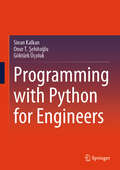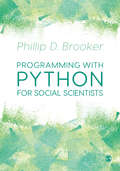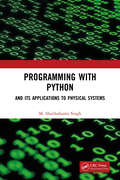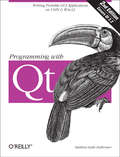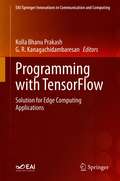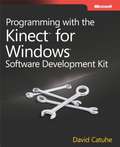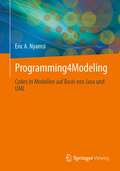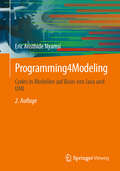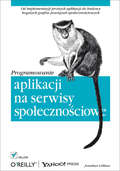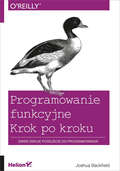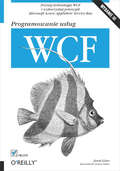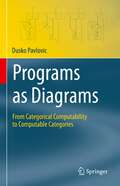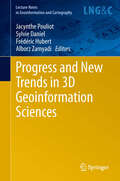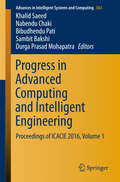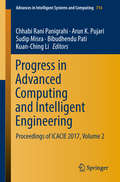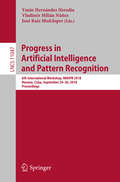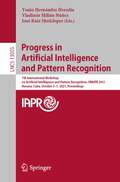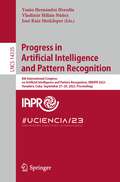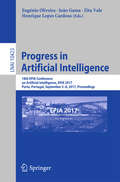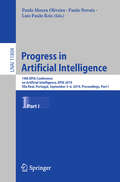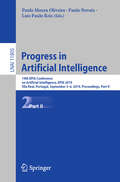- Table View
- List View
Programming with Python for Engineers
by Göktürk Üçoluk Sinan Kalkan Onur T. ŞehitoğluThis book introduces computing and programming with undergraduate engineering students in mind. It uses Python (Version 3) as the programming language, chosen for its simplicity, readability, wide applicability and large collection of libraries. After introducing engineering-related Python libraries, such as NumPy, Pandas, Matplotlib, Sci-kit, Programming with Python for Engineers shows how Python can be used to implement methods common in a wide spectrum of engineering-related problems drawn from (for example): design, control, decision-making, scheduling and planning. Important features of the book include the following: The book contains interactive content for illustration of important concepts, where the user can provide input and by clicking buttons, trace through the steps. Each chapter is also accessible as a Jupyter Notebook page and every code piece is executable. This allows the readers to run code examples in chapters immediately, to make changes and gain a better grasp of the concepts presented. The coverage of topics is complemented by illustrative examples and exercises. For instructors adopting the textbook, a solutions manual is provided at https://sites.google.com/springernature.com/extramaterial/lecturer-material.
Programming with Python for Social Scientists
by Phillip BrookerAs data become ′big′, fast and complex, the software and computing tools needed to manage and analyse them are rapidly developing. Social scientists need new tools to meet these challenges, tackle big datasets, while also developing a more nuanced understanding of - and control over - how these computing tools and algorithms are implemented. Programming with Python for Social Scientists offers a vital foundation to one of the most popular programming tools in computer science, specifically for social science researchers, assuming no prior coding knowledge. It guides you through the full research process, from question to publication, including: the fundamentals of why and how to do your own programming in social scientific research, questions of ethics and research design, a clear, easy to follow ′how-to′ guide to using Python, with a wide array of applications such as data visualisation, social media data research, social network analysis, and more. Accompanied by numerous code examples, screenshots, sample data sources, this is the textbook for social scientists looking for a complete introduction to programming with Python and incorporating it into their research design and analysis.
Programming with Python: And Its Applications to Physical Systems
by M. Shubhakanta SinghThis book is an introduction to Python Programming and provides a practical approach to the subject. The basic concepts of Python are explained in detail and augmented with examples and diagrams for a thorough understanding of the subject. The book is primarily aimed at students with little or no prior knowledge of programming languages. However, self-taught and hobbyist programmers, scientists, engineers, computing professionals and computer scientists and others who need to program as part of their work may also use this book for understanding the basic concepts of Python. Print edition not for sale in South Asia (India, Sri Lanka, Nepal, Bangladesh, Pakistan or Bhutan)
Programming with Qt: Writing Portable GUI applications on Unix and Win32
by Matthias Kalle DalheimerThe popular open source KDE desktop environment for Unix was built with Qt, a C++ class library for writing GUI applications that run on Unix, Linux, Windows 95/98, Windows 2000, and Windows NT platforms. Qt emulates the look and feel of Motif, but is much easier to use. Best of all, after you have written an application with Qt, all you have to do is recompile it to have a version that works on Windows. Qt also emulates the look and feel of Windows, so your users get native-looking interfaces.Platform independence is not the only benefit. Qt is flexible and highly optimized. You'll find that you need to write very little, if any, platform-dependent code because Qt already has what you need. And Qt is free for open source and Linux development.Although programming with Qt is straightforward and feels natural once you get the hang of it, the learning curve can be steep. Qt comes with excellent reference documentation, but beginners often find the included tutorial is not enough to really get started with Qt. That's whereProgramming with Qt steps in. You'll learn how to program in Qt as the book guides you through the steps of writing a simple paint application. Exercises with fully worked out answers help you deepen your understanding of the topics. The book presents all of the GUI elements in Qt, along with advice about when and how to use them, so you can make full use of the toolkit. For seasoned Qt programmers, there's also lots of information on advanced 2D transformations, drag-and-drop, writing custom image file filters, networking with the new Qt Network Extension, XML processing, Unicode handling, and more.Programming with Qt helps you get the most out of this powerful, easy-to-use, cross-platform toolkit. It's been completely updated for Qt Version 3.0 and includes entirely new information on rich text, Unicode/double byte characters, internationalization, and network programming.
Programming with TensorFlow: Solution for Edge Computing Applications (EAI/Springer Innovations in Communication and Computing)
by G. R. Kanagachidambaresan Kolla Bhanu PrakashThis practical book provides an end-to-end guide to TensorFlow, the leading open source software library that helps you build and train neural networks for deep learning, Natural Language Processing (NLP), speech recognition, and general predictive analytics. The book provides a hands-on approach to TensorFlow fundamentals for a broad technical audience—from data scientists and engineers to students and researchers. The authors begin by working through some basic examples in TensorFlow before diving deeper into topics such as CNN, RNN, LSTM, and GNN. The book is written for those who want to build powerful, robust, and accurate predictive models with the power of TensorFlow, combined with other open source Python libraries. The authors demonstrate TensorFlow projects on Single Board Computers (SBCs).
Programming with Types: Examples in TypeScript
by Vlad RiscutiaType-related failures are common and can be very costly. Famously, in 1999, NASA's Mars Climate Orbiter burned up in the atmosphere because of an error that could have easily been prevented with typing. By taking advantage of the strong type systems available in most modern programming languages, you can eliminate whole classes of errors. Programming with Types teaches you type system techniques for writing software that's safe, correct, easy to test and maintain, and that practically documents itself. Master these techniques, and you may even help prevent an interstellar catastrophe!Purchase of the print book includes a free eBook in PDF, Kindle, and ePub formats from Manning Publications.
Programming with the KinectTM for Windows® Software Development Kit
by David Catuhe<p>Create rich experiences for users of Windows 7 and Windows 8 Developer Preview with this pragmatic guide to the Kinect for Windows Software Development Kit (SDK).</p>
Programming4Modeling: Codes in Modellen auf Basis von Java und UML
by Eric A. NyamsiDas Buch fokussiert auf objektorientierte Softwareentwicklung in Bezug auf das Konzept "Programming4Modeling" genannt "P4M". Es stellt zum einen die Analyse und Design für die Modellierung mit UML und zum anderen die Softwareentwicklung mit Java dar. Das Buch wirft folgende Fragen auf: Wie ist die Architektur eines Klassenmodells? Welche Codes ermöglichen eine effiziente Softwareentwicklung? Was sind die Schnittpunkte von Codes und Modellen?
Programming4Modeling: Codes in Modellen auf Basis von Java und UML
by Eric Aristhide NyamsiDas Buch fokussiert auf objektorientierte Softwareentwicklung in Bezug auf das Konzept „Programming4Modeling“ genannt „P4M“. Es stellt zum einen die Analyse und Design für die Modellierung mit UML und zum anderen die Softwareentwicklung mit Java dar. Das Buch wirft folgende Fragen auf: Wie ist die Architektur eines Klassenmodells? Welche Codes ermöglichen eine effiziente Softwareentwicklung? Was sind die Schnittpunkte von Codes und Modellen?
Programowanie aplikacji na serwisy spo?eczno?ciowe
by Jonathan LeBlancJedyny podr?cznik o platformie OpenSocial!Serwisy spo?eczno?ciowe w zasadzie z dnia na dzie? opanowa?y Internet. Mówi? o nich wszyscy i korzystaj? z nich wszyscy! Przez krótki okres u?ywa?y ich tylko osoby prywatne, jednak b?yskawicznie ich potencja? dostrzeg?y tak?e firmy. Jest to dla nich najprawdopodobniej najlepszy kana? komunikacji z klientami. Dlatego podczas tworzenia nowych rozwi?za? czy nowych serwisów warto rozwa?y? integracj? z popularnymi serwisami spo?eczno?ciowymi oraz wprowadzenie w?asnych elementów tego typu.To zadanie ma u?atwi? platforma OpenSocial, na której koncentruje si? ta ksi??ka. Dowiesz si? st?d, jak tworzy? niezale?ne aplikacje dla istniej?cych serwisów, jak budowa? grafy powi?za? spo?eczno?ciowych oraz tworzy? produkty spe?niaj?ce oczekiwania samego autora jako u?ytkownika us?ug spo?eczno?ciowych.W trakcie lektury nauczysz si? odwzorowywa? relacje pomi?dzy u?ytkownikami oraz dostosowywa? dostarczane im tre?ci na podstawie danych zawartych w ich profilach. Ponadto zdob?dziesz solidn? dawk? wiedzy na temat bezpiecze?stwa oraz najlepszych technik autoryzacji u?ytkowników na platformie OpenSocial. Sprawdzisz, jak przenie?? aplikacj? napisan? dla Facebooka na platform? OpenSocial, oraz poznasz niuanse konfigurowania ?rodowiska produkcyjnego. Ksi??ka ta jest wyj?tkow? pozycj? na rynku, po?wi?con? platformie OpenSocial. Wykorzystaj jej potencja? i stwórz nowatorskie oprogramowanie!Poznaj mo?liwo?ci platformy OpenSocial!Skonfiguruj ?rodowisko produkcyjneOdwzoruj relacje pomi?dzy u?ytkownikamiStwórz interesuj?ce gad?etySkorzystaj z zaawansowanych mechanizmów identyfikacjiPrzenie? aplikacj? z serwisu Facebook na platform? OpenSocialPostaw na otwarte standardy!
Programowanie funkcyjne. Krok po kroku
by Joshua BackfieldZmie? swoje podej?cie do programowania!J?zyki funkcyjne zdobywaj? w?ród programistów coraz wi?ksz? popularno??. Jak bezbole?nie zmieni? sposób my?lenia na funkcyjny? U?atwi Ci to niniejsza ksi??ka, w ca?o?ci po?wi?cona temu podej?ciu do programowania.Poznaj podstawy teoretyczne programowania funkcyjnego, a nast?pnie zacznij zg??bia? tajniki typów funkcyjnych, rekurencji oraz zmiennych niepodlegaj?cych modyfikacji. Z kolejnych rozdzia?ów dowiedz si?, czym s? ewaluacja rygorystyczna i nierygorystyczna. Zobacz te?, jak wykona? dopasowanie do wzorca. Co jeszcze znajdziesz w tej ksi??ce? Wprowadzenie do j?zyka Scala, przedstawienie j?zyka Groovy oraz opis technik funkcyjnego programowania obiektowego to tylko niektóre z poruszanych w niej tematów. Je?eli chcesz zmieni? sposób programowania na funkcyjny, to doskona?a pozycja dla Ciebie!Dzi?ki tej ksi??ce: poznasz podstawy teoretyczne programowania funkcyjnego zaznajomisz si? z typami funkcyjnymi wykorzystasz funkcje anonimowe poznasz nowe wzorce projektowe zmienisz swoje podej?cie do programowaniaPrzekonaj si?, jak podej?cie funkcyjne mo?e u?atwi? Ci ?ycie!O autorzeJoshua F. Backfield jest starszym in?ynierem ds. rozwoju oprogramowania w firmie Dell SecureWorks, która jest wiod?cym w bran?y dostawc? zarz?dzalnych us?ug zabezpiecze? (ang. managed security service provider — MSSP). Jest odpowiedzialny za projektowanie i rozwój wielu wewn?trznych narz?dzi interfejsu u?ytkownika, a tak?e wielu procesów backendowych. Posiada tytu? licencjata technologii systemów elektronicznych z Southern Illinois University w Carbondale i tytu? magistra w dziedzinie informatyki z DePaul University. Pracowa? w wielu ró?nych j?zykach programowania, takich jak C, C++, Perl, Java, JavaScript oraz Scala, i wci?? uczy si? kolejnych. Przeniós? wiele natywnych aplikacji j?zyka C do j?zyka Scala. Wprowadzi? tak?e wielu swoich wspó?pracowników w tajniki j?zyka Scala i nauczy? ich jego podstawowych koncepcji programowania funkcyjnego.
Programowanie uk?adów AVR dla praktyków
by Elliot WilliamsProgramowanie uk?adów AVR dla pasjonatów!Wspó?czesny ?wiat elektroniki jest podbijany przez uk?ad Arduino. Przemawia za nim wygoda oraz proste tworzenie ca?kiem zaawansowanych projektów. Je?eli jednak wymagasz najwy?szej wydajno?ci, reakcji na zdarzenia w czasie rzeczywistym lub wielozadaniowo?ci, warto, ?eby? wykona? kolejny krok i pozna? uk?ady AVR firmy Atmel. Brzmi zach?caj?co?Doskonale! W Twoje r?ce oddajemy ksi??k?, która pozwoli Ci pozna? pasjonuj?cy ?wiat tych uk?adów. W kolejnych rozdzia?ach nauczysz si? wykorzystywa? ich potencja? do pisania swoich w?asnych programów w j?zyku C oraz komunikowania si? ze ?wiatem zewn?trznym. Ponadto dowiesz si?, jak korzysta? z komunikacji szeregowej, wej?? cyfrowych oraz przerwa? sprz?towych. Na sam koniec, w cz??ci po?wi?conej zaawansowanym zagadnieniom, zobaczysz, jak u?ywa? prze??czników i protoko?u I2C oraz sterowa? silnikami. Ksi??ka ta przyda si? wszystkim pasjonatom elektroniki, którzy pragn? odkry? potencja? uk?adów AVR.Dzi?ki tej ksi??ce: skompletujesz potrzebne narz?dzia nauczysz si? programowa? uk?ady AVR wykorzystasz Arduino do programowania AVR zastosujesz przerwania sprz?towe u?yjesz uk?adu AVR w zaawansowanych projektachWykorzystaj potencja? uk?adów AVR!
Programowanie us?ug WCF
by Juval LöwyPoznaj technologi? WCF i wykorzystaj potencja? Microsoft Azure AppFabric Service BusUdost?pnianie us?ug sieciowych to ju? nie tylko widzimisi? programistów lub projektantów - w dzisiejszych czasach to obowi?zek! Dzi?ki temu u?atwiasz integracj? innych aplikacji z Twoim produktem, ale te? z ?atwo?ci? korzystasz z funkcjonalno?ci dostarczanych przez innych producentów. Najwa?niejsze jest jednak to, ?e najwi?cej zyskuje Twój klient. A jego zadowolenie zapewni Ci sukces i byt na rynku!Je?eli podj??e? decyzj?, ?e Twoja kolejna aplikacja b?dzie wspiera?a WCF, to wybieraj?c t? ksi??k?, nie mog?e? trafi? lepiej. "Programowanie us?ug WCF" to doskona?y, ciesz?cy si? ogromn? popularno?ci? przewodnik, po?wi?cony spójnej, jednolitej platformie firmy Microsoft, któr? zaprojektowano z my?l? o programowaniu aplikacji w oparciu o us?ugi dla systemu Windows. Jej autor Juval Löwy jest wybitnym specjalist? w dziedzinie platformy .NET i technologii WCF. W trakcie lektury poznasz architektur? technologii WCF, jej elementy sk?adowe oraz zagadnienia zwi?zane z jej niezawodno?ci?. Ponadto dowiesz si?, jak zagwarantowa? bezpiecze?stwo swoim us?ugom sieciowym, oraz sprawdzisz mo?liwo?ci magistrali us?ug Azure AppFabric Service Bus. Wiedza, któr? zdob?dziesz, pozwoli Ci na tworzenie jeszcze lepszych i bardziej elastycznych projektów informatycznych. Sprawd? sam!Poznaj architektur? technologii WCF i jej podstawowe elementy sk?adowe, w tym tak wa?ne poj?cia, jak niezawodno?? czy sesja transportowaNaucz si? u?ywa? wbudowanych elementów, takich jak hosty us?ug, mechanizmy zarz?dzania instancjami i wspó?bie?no?ci?, transakcje, kolejkowane wywo?ania roz??czonych us?ug, zabezpieczenia czy odkrywanieOpanuj sztuk? korzystania z magistrali us?ug Azure AppFabric Service Bus, czyli najbardziej rewolucyjnego elementu nowego projektu chmury obliczeniowejPodnie? swoj? produktywno?? i jako?? tworzonych us?ug WCF dzi?ki odpowiednim opcjom projektowym, wskazówkom i zalecanym praktykom, zawartym we frameworku ServiceModelEx autorstwa Juvala Löwy’egoPoznaj uzasadnienie szczegó?owych decyzji projektowych i odkryj najtrudniejsze, rozumiane przez niewielu programistów aspekty programowania us?ug WCFNajlepszy podr?cznik po?wi?cony WCF!
Programs as Diagrams: From Categorical Computability to Computable Categories (Theory and Applications of Computability)
by Dusko PavlovicIt is not always clear what computer programs mean in the various languages in which they can be written, yet a picture can be worth 1000 words, a diagram 1000 instructions. In this unique textbook/reference, programs are drawn as string diagrams in the language of categories, which display a universal syntax of mathematics (Computer scientists use them to analyze the program semantics; programmers to display the syntax of computations). Here, the string-diagrammatic depictions of computations are construed as programs in a single-instruction programming language. Such programs as diagrams show how functions are packed in boxes and tied by strings. Readers familiar with categories will learn about the foundations of computability; readers familiar with computability gain access to category theory. Additionally, readers familiar with both are offered many opportunities to improve the approach. Topics and features: Delivers a ‘crash’ diagram-based course in theory of computationUses single-instruction diagrammatic programming languageOffers a practical introduction into categories and string diagrams as computational toolsReveals how computability is programmability, rather than an ‘ether’ permeating computers Provides a categorical model of intensional computation is unique up to isomorphismServes as a stepping stone into research of computable categories In addition to its early chapters introducing computability for beginners, this flexible textbook/resource also contains both middle chapters that expand for suitability to a graduate course as well as final chapters opening up new research. Dusko Pavlovic is a professor at the Department of Information and Computer Sciences at the University of Hawaii at Manoa, and by courtesy at the Department of Mathematics and the College of Engineering. He completed this book as an Excellence Professor at Radboud University in Nijmegen, The Netherlands.
Progress and New Trends in 3D Geoinformation Sciences
by Alborz Zamyadi Frédéric Hubert Jacynthe Pouliot Sylvie DanielThe integration of the 3rd dimension in the production of spatial representation is largely recognized as a valuable approach to comprehend our reality, that is 3D. During the last decade developments in 3D Geoinformation (GI) system have made substantial progress. We are about to have a more complete spatial model and understanding of our planet in different scales. Hence, various communities and cities offer 3D landscape and 3D city models as valuable source and instrument for sustainable management of rural and urban resources. Also municipal utilities, real estate companies benefit from recent developments related to 3D applications. In order to present recent developments and to discuss future trends, academics and practitioners met at the 7th International Workshop on 3D Geoinformation. This book comprises a selection of evaluated, high quality papers that were presented at this workshop in May 2012. The topics focus explicitly on the last achievements (methods, algorithms, models, systems) with respect to 3D GeoInformation requirements. The book is aimed at decision makers and experts as well at students interested in the 3D component of geographical information science including GI engineers, computer scientists, photogrammetrists, land surveyors, urban planners, and mapping specialists.
Progress in Advanced Computing and Intelligent Engineering: Proceedings Of Icacie 2017, Volume 2 (Advances in Intelligent Systems and Computing #714)
by Sudip Misra Bibudhendu Pati Sambit Bakshi Chhabi Rani Panigrahi Arun K. PujariThe book gathers high-quality research papers presented at the International Conference on Advanced Computing and Intelligent Engineering (ICACIE 2017). It includes technical sections describing progress in the fields of advanced computing and intelligent engineering, and is primarily intended for postgraduate students and researchers working in Computer Science and Engineering. However, researchers working in Electronics will also find the book useful, as it addresses hardware technologies and next-gen communication technologies.
Progress in Advanced Computing and Intelligent Engineering: Proceedings of ICACIE 2016, Volume 1 (Advances in Intelligent Systems and Computing #563)
by Khalid Saeed Nabendu Chaki Durga Prasad Mohapatra Bibudhendu Pati Sambit BakshiThe book focuses on both theory and applications in the broad areas of communication technology, computer science and information security. This two volume book contains the Proceedings of International Conference on Advanced Computing and Intelligent Engineering. These volumes bring together academic scientists, professors, research scholars and students to share and disseminate information on knowledge and scientific research works related to computing, networking, and informatics to discuss the practical challenges encountered and the solutions adopted. The book also promotes translation of basic research into applied investigation and convert applied investigation into practice.
Progress in Advanced Computing and Intelligent Engineering: Proceedings of ICACIE 2017, Volume 2 (Advances in Intelligent Systems and Computing #714)
by Sudip Misra Kuan-Ching Li Bibudhendu Pati Chhabi Rani Panigrahi Arun K. PujariThis book features high-quality research papers presented at the International Conference on Advanced Computing and Intelligent Engineering (ICACIE 2017). It includes sections describing technical advances in the fields of advanced computing and intelligent engineering, which are based on the presented articles. Intended for postgraduate students and researchers working in the discipline of computer science and engineering, the proceedings also appeal to researchers in the domain of electronics as it covers hardware technologies and future communication technologies.
Progress in Advanced Computing and Intelligent Engineering: Proceedings of ICACIE 2020 (Advances in Intelligent Systems and Computing #1299)
by Kuan-Ching Li Bibudhendu Pati Chhabi Rani Panigrahi Binod Kumar Pattanayak Seeven AmicThis book focuses on theory, practice and applications in the broad areas of advanced computing techniques and intelligent engineering. This book includes 74 scholarly articles which were accepted for presentation from 294 submissions in the 5th ICACIE during 25–27 June 2020 at Université des Mascareignes (UdM), Mauritius, in collaboration with Rama Devi Women’s University, Bhubaneswar, India, and S‘O’A Deemed to be University, Bhubaneswar, India. This book brings together academicians, industry persons, research scholars and students to share and disseminate their knowledge and scientific research work related to advanced computing and intelligent engineering. It helps to provide a platform to the young researchers to find the practical challenges encountered in these areas of research and the solutions adopted. The book helps to disseminate the knowledge about some innovative and active research directions in the field of advanced computing techniques and intelligent engineering, along with some current issues and applications of related topics.
Progress in Artificial Intelligence and Pattern Recognition: 6th International Workshop, IWAIPR 2018, Havana, Cuba, September 24–26, 2018, Proceedings (Lecture Notes in Computer Science #11047)
by Yanio Hernández Heredia Vladimir Milián Núñez José Ruiz ShulcloperThis book constitutes the refereed proceedings of the 6th International Workshop on Artificial Intelligence and Pattern Recognition, IWAIPR 2018, held in Havana, Cuba, in September 2018. The 42 full papers presented were carefully reviewed and selected from 101 submissions. The papers promote and disseminate ongoing research on mathematical methods and computing techniques for artificial intelligence and pattern recognition, in particular in bioinformatics, cognitive and humanoid vision, computer vision, image analysis and intelligent data analysis, as well as their application in a number of diverse areas such as industry, health, robotics, data mining, opinion mining and sentiment analysis, telecommunications, document analysis, and natural language processing and recognition.
Progress in Artificial Intelligence and Pattern Recognition: 7th International Workshop on Artificial Intelligence and Pattern Recognition, IWAIPR 2021, Havana, Cuba, October 5–7, 2021, Proceedings (Lecture Notes in Computer Science #13055)
by Yanio Hernández Heredia Vladimir Milián Núñez José Ruiz ShulcloperThis book constitutes the refereed proceedings of the 7th International Workshop on Artificial Intelligence and Pattern Recognition, IWAIPR 2021, held in Havana, Cuba, in October 2021. The 42 full papers presented were carefully reviewed and selected from 73 submissions. The papers promote and disseminate ongoing research on mathematical methods and computing techniques for artificial intelligence and pattern recognition, in particular in bioinformatics, cognitive and humanoid vision, computer vision, image analysis and intelligent data analysis.
Progress in Artificial Intelligence and Pattern Recognition: 8th International Congress on Artificial Intelligence and Pattern Recognition, IWAIPR 2023, Varadero, Cuba, September 27–29, 2023, Proceedings (Lecture Notes in Computer Science #14335)
by Yanio Hernández Heredia Vladimir Milián Núñez José Ruiz ShulcloperThis book constitutes the refereed proceedings of the 8th International Workshop on Artificial Intelligence and Pattern Recognition, IWAIPR 2023, held in Varadero, Cuba, in October 2023. The 68 papers presented in the proceedings set were carefully reviewed and selected from 38 submissions. The IWAIPR conference aims to provide a leading international forum to promote and disseminate ongoing research into mathematical methods of computing techniques for Artifical Intelligence and Pattern Recognition.
Progress in Artificial Intelligence: 18th EPIA Conference on Artificial Intelligence, EPIA 2017, Porto, Portugal, September 5-8, 2017, Proceedings (Lecture Notes in Computer Science #10423)
by Zita Vale Eugénio Oliveira João Gama Henrique Lopes CardosoThis book constitutes the refereed proceedings of the 18th Portuguese Conference on Artificial Intelligence, EPIA 2017, held in Porto, Portugal, in September 2017. The 69 revised full papers and 2 short papers presented were carefully reviewed and selected from a total of 177 submissions. The papers are organized in 16 tracks devoted to the following topics: agent-based modelling for criminological research (ABM4Crime), artificial intelligence in cyber-physical and distributed embedded systems (AICPDES), artificial intelligence in games (AIG), artificial intelligence in medicine (AIM), artificial intelligence in power and energy systems (AIPES), artificial intelligence in transportation systems (AITS), artificial life and evolutionary algorithms (ALEA), ambient intelligence and affective environments (AmIA), business applications of artificial intelligence (BAAI), intelligent robotics (IROBOT), knowledge discovery and business intelligence (KDBI), knowledge representation and reasoning (KRR), multi-agent systems: theory and applications (MASTA), software engineering for autonomous and intelligent systems (SE4AIS), social simulation and modelling (SSM), and text mining and applications (TeMA).
Progress in Artificial Intelligence: 19th EPIA Conference on Artificial Intelligence, EPIA 2019, Vila Real, Portugal, September 3–6, 2019, Proceedings, Part I (Lecture Notes in Computer Science #11804)
by Paulo Novais Luís Paulo Reis Paulo Moura OliveiraThis book constitutes the refereed proceedings of the 19th EPIA Conference on Artificial Intelligence, EPIA 2019, held in Funchal, Madeira, Portugal, in September 2019. The 119 revised full papers and 6 short papers presented were carefully reviewed and selected from a total of 252 submissions. The papers are organized in 18 tracks devoted to the following topics: AIEd - Artificial Intelligence in Education, AI4G - Artificial Intelligence for Games, AIoTA - Artificial Intelligence and IoT in Agriculture, AIL - Artificial Intelligence and Law, AIM - Artificial Intelligence in Medicine, AICPDES - Artificial Intelligence in Cyber-Physical and Distributed Embedded Systems, AIPES - Artificial Intelligence in Power and Energy Systems, AITS - Artificial Intelligence in Transportation Systems, ALEA - Artificial Life and Evolutionary Algorithms, AmIA - Ambient Intelligence and Affective Environments, BAAI - Business Applications of Artificial Intelligence, GAI- General AI, IROBOT - Intelligent Robotics, KDBI - Knowledge Discovery and Business Intelligence, KRR - Knowledge Representation and Reasoning, MASTA - Multi-Agent Systems: Theory and Applications, SSM - Social Simulation and Modelling, TeMA - Text Mining and Applications.
Progress in Artificial Intelligence: 19th EPIA Conference on Artificial Intelligence, EPIA 2019, Vila Real, Portugal, September 3–6, 2019, Proceedings, Part II (Lecture Notes in Computer Science #11805)
by Paulo Novais Luís Paulo Reis Paulo Moura OliveiraThis book constitutes the refereed proceedings of the 19th EPIA Conference on Artificial Intelligence, EPIA 2019, held in Funchal, Madeira, Portugal, in September 2019. The 119 revised full papers and 6 short papers presented were carefully reviewed and selected from a total of 252 submissions. The papers are organized in 18 tracks devoted to the following topics: AIEd - Artificial Intelligence in Education, AI4G - Artificial Intelligence for Games, AIoTA - Artificial Intelligence and IoT in Agriculture, AIL - Artificial Intelligence and Law, AIM - Artificial Intelligence in Medicine, AICPDES - Artificial Intelligence in Cyber-Physical and Distributed Embedded Systems, AIPES - Artificial Intelligence in Power and Energy Systems, AITS - Artificial Intelligence in Transportation Systems, ALEA - Artificial Life and Evolutionary Algorithms, AmIA - Ambient Intelligence and Affective Environments, BAAI - Business Applications of Artificial Intelligence, GAI- General AI, IROBOT - Intelligent Robotics, KDBI - Knowledge Discovery and Business Intelligence, KRR - Knowledge Representation and Reasoning, MASTA - Multi-Agent Systems: Theory and Applications, SSM - Social Simulation and Modelling, TeMA - Text Mining and Applications.
